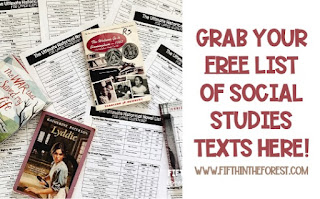If there's one thing we all need more of, it's time. Learn how to save it here!
My first year teaching I struggled with time management. There was NEVER enough time to get through the standards. My lesson plans were a rushed and in-cohesive. I felt like I was drowning coming up with new ideas for every subject. But then I realized there's a better way!
In my search for more time, I realized there's simply no way to find more. I simply had to use it more wisely. Ever been there?
Enter cross-curricular activities. Once I began combining my standards for ELA, science, and social studies I felt like a weight was lifted. We could finally dive deeper into the curriculum and my students were retaining more. It was a miracle!
Keep reading for 5 strategies I began using to cross-curriculum in the classroom and multiply time.
1. Always reinforce social studies and science topics by using them as ELA mentor texts.
I know you're using mentor texts, right? Well stop grabbing random books off your shelf! Purposely choose books that connect to your current social studies/science curriculum. For example, if you are practicing narrative writing (W.5.3) and the Cold War, reading Mercedes and the Chocolate Pilot would be an excellent choice!
But in order to choose purposeful books, you need to know books. I can help! Download this FREE list of Social Studies books divided by topics simply by signing up for my newsletter. If you choose to unsubscribe later--no worries!
2. Technology should be used wisely.
Many of us have required time in a technology lab or with carts of tablets/computers. It's tempting to let students read articles, do math drills, etc. that don't take any planning on our end. But with just a little bit of effort, that time can be used wisely.
Try to assign projects and activities that relate to multiple subject areas. For example: working on a group presentation can incorporate research, summarizing, note-taking, and speaking standards--plus many more! When you bring in your social studies curriculum as a topic, the activity is that much richer!
If you're looking for places to find books/reading online, check out this blog post!
3. Be purposeful with your classroom library.
This seems simple, but your library should be filled with books that relate to your curriculum. Additionally, when you start a new topic, bring related books off the shelf! Display them in sight and let students borrow and read. (I like to put a few on the ledge below my white board).
Need books that relate to your social studies topics? Grab my FREE list here!
But filling a classroom library takes a lot of money, right? It doesn't have to! Check out this blog post with cheap ways to build a library.
4. Work with other teachers in your school.
Do the special area teachers know what you are working on? They should! Allow these gifted teachers to come alongside and reinforce your standards. Music, art, and movement teachers are so creative and can incorporate science/social studies topics well. (I know some like to do their own thing...but give them a chance!)
Consider giving these teachers a rough outline for your grade level. For example: 1st semester we will study the Civil War and Reconstruction. 2nd quarter we will student Immigration, Industrialization, and WWI, etc.
5. Be prepared with independent reading suggestions.
When students find a particular interest, be prepared to suggest additional books in that same subject area. This applies to ANY social studies or science topic you cover. For ways to help students find books they'll love, check out this blog post!
PS! Don't forget to download THIS FREE LIST to get all those book suggestions. It is organized, printable, and READY to go!
Look for other helpful posts? Check out these!
- How to Make Time for Classroom Read Alouds
- 5 Ways to Make Read Alouds More Meaningful
- Top Ten Read Alouds for 3rd Grade
- Top Ten Read Alouds for 4th Grade
- Top Ten Read Alouds for 5th Grade







No comments
Post a Comment